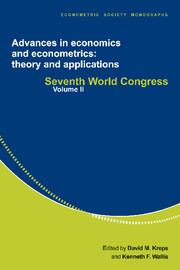Book contents
- Frontmatter
- 1 Incentives and careers in organizations
- 2 Endogenous growth: lessons for and from economic history
- 3 Microtheory and recent developments in the study of economic institutions through economic history
- 4 Poverty traps
- 5 Microenterprise and macropolicy
- 6 Markets in transition
- 7 Transition as a process of large-scale institutional change
- 8 A Schumpeterian perspective on growth and competition
- 9 Learning and growth
- Index
9 - Learning and growth
Published online by Cambridge University Press: 05 January 2013
- Frontmatter
- 1 Incentives and careers in organizations
- 2 Endogenous growth: lessons for and from economic history
- 3 Microtheory and recent developments in the study of economic institutions through economic history
- 4 Poverty traps
- 5 Microenterprise and macropolicy
- 6 Markets in transition
- 7 Transition as a process of large-scale institutional change
- 8 A Schumpeterian perspective on growth and competition
- 9 Learning and growth
- Index
Summary
INTRODUCTION
In this survey, I discuss four sources of growth of knowledge: research, schooling, learning by doing, and training. In trying to disentangle what is important, I emphasize the following facts: (1) even the most advanced countries spend far more on adoption of existing technologies than on inventing new ones, and (2) countries frequently adopt “dominated” technologies. These facts provide a useful background for evaluating the different theories. They will also sharpen the point that it is important to distinguish between technology and human capital.
The conclusion is two fold: First, for world growth, research outlays surely are essential. But for most agents in most countries, productivity growth is the result of their adopting existing technologies. This point deserves more emphasis than it has so far been given. Second, in the field of growth, theory is not much disciplined by fact - the handful of models that I survey contains a bewildering array of diverse engines of growth, few of which are based on any firm evidence.
I find that it helps to use the following terminology: Define technologies to be laws of physics that are relevant to a particular way of producing something. These laws are described in blueprints. A blueprint, however, is an incomplete description of what it is useful to know about the technology at hand. For example, even a thick manual - say a computer manual – does not guarantee that its reader will be able to use the technology effectively right away. Human capital is the knowledge of how to work the blueprints. The blueprint's incompleteness creates a role for training and learning by doing as ways of building up the technology-specific human capital. Features of technologies that can be clearly explained in manuals will not call for training or experience. Other features of the optimal decision are specific to the situation at hand, to the nature of the factors of production, the raw materials, the location, the workspace, the specifications of the output, and so on. These, the workers will have to be taught, or they will have to infer them through trail and error.
- Type
- Chapter
- Information
- Advances in Economics and Econometrics: Theory and ApplicationsSeventh World Congress, pp. 318 - 339Publisher: Cambridge University PressPrint publication year: 1997
- 18
- Cited by

